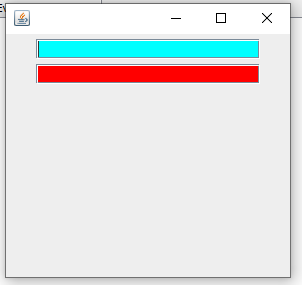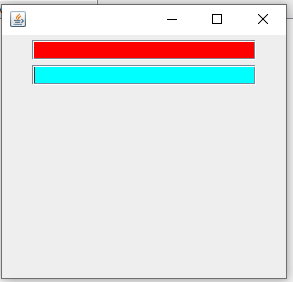java
Focus Event and Key Event in Java With Examples
Focus Event in Java with Examples
Table of Contents
a) Introduction
b) Different Method of Focus Event
c) Example with Source code
d) Output
*********************
Introduction
Focus Event is the low-level event which indicates
the focus gained or focus lost from the keyboard. It is generated by the
components such as text field. The event generated is passed through every FocusListener
or FocusAdapter
objects which is registered by addFocusListener to receive the
event.
The methods of the Focus Event are:
public void focusGained(FocusEvent e)
public void focusLost(FocusEvent e)
Let us see the example of Focus Event using FocusListener;
To use the FocusListener
interface we have to implement it to the main class as shown in below code.
Source Code:
/*
* To change this license
header, choose License Headers in Project Properties.
* To change this template
file, choose Tools | Templates
* and open the template
in the editor.
*/
package EventHandling;
/**
*
* @author AnkitPC
*/
import javax.swing.*;
import java.awt.*;
import java.awt.event.*;
public class FocusEventDemo implements FocusListener{
JFrame f1;
JTextField t1, t2;
FocusEventDemo(){
f1= new JFrame();
f1.setSize(300,
300); //size of frame
f1.setLayout(new
FlowLayout()); //setting layout
f1.setDefaultCloseOperation(JFrame.DISPOSE_ON_CLOSE);
t1= new
JTextField(20);
t2= new
JTextField(20);
//adding component
to the frame
f1.add(t1);
f1.add(t2);
//registering the
event
t1.addFocusListener(this);
t2.addFocusListener(this);
f1.setVisible(true);
}
public static void
main(String[] args) {
new
FocusEventDemo(); //calling constructor
}
public void
focusGained(FocusEvent e){
if(e.getSource()==t1){
t1.setBackground(Color.cyan);
}
else if(e.getSource()==t2){
t2.setBackground(Color.cyan);
}
}
public void
focusLost(FocusEvent e){
if(e.getSource()==t1){
t1.setBackground(Color.red);
}
else
if(e.getSource()==t2){
t2.setBackground(Color.red);
}
}
}
If we use Listener interface than we have to
override the all methods that is in Focus Listener. As you can see that there
are only two methods of focus event so we override both. In the source code you
can see that when focus is gained then it shows the color cyan and if focus is
lost then it shows the color red.
Output:
In this figure above, focus is gained by the text field first and focus is lost in text field second.
Now in the figure above you can see the focus is gained by the second text field and lost by first text field.
Also let us see the example of Focus Event using FocusAdpater;
To use FocusAdapter
we extend the Adapter class to the main class as shown in the code below.
Source Code:
/*
* To change this license
header, choose License Headers in Project Properties.
* To change this template
file, choose Tools | Templates
* and open the template
in the editor.
*/
package EventHandling;
/**
*
* @author AnkitPC
*/
import javax.swing.*;
import java.awt.*;
import java.awt.event.*;
public class FocusEventDemo extends FocusAdapter{
JFrame f1;
JTextField t1, t2;
FocusEventDemo(){
f1= new JFrame();
f1.setSize(300,
300); //size of frame
f1.setLayout(new
FlowLayout()); //setting layout
f1.setDefaultCloseOperation(JFrame.DISPOSE_ON_CLOSE);
t1= new
JTextField(20);
t2= new
JTextField(20);
//adding component
to the frame
f1.add(t1);
f1.add(t2);
//registering the
event
t1.addFocusListener(this);
t2.addFocusListener(this);
f1.setVisible(true);
}
public static void
main(String[] args) {
new
FocusEventDemo(); //calling constructor
}
public void
focusGained(FocusEvent e){
if(e.getSource()==t1){
t1.setBackground(Color.cyan);
}
else
if(e.getSource()==t2){
t2.setBackground(Color.cyan);
}
}
}
Now in the source code above you can see that I have
removed the focusLost method. But also the code is working, So the main reason
of using the Adapter class over Listener interface is that we can override the
method which is required.
Output:
In the above code i have removed the method focusLost so it only shows the focus gained by the textfield.
Key Event in Java with Examples
Table of Contents
a) Introduction to Key Event
b) Different types of methods of Key Event
c) Example with Source Code
d) Output
****************
Introduction
Key Event is generates if and only if the state of
the key is changed. It is generated by the components such as text field. The
event generated is passed through every KeyListener
or KeyAdapter
objects which is registered by addKeyListener to receive the
event. The interface KeyListener and class KeyAdapter
is found in java.awt.event package.
Key Event has three methods, they are;
a) public void keyPressed(KeyEvent e)
b) public void keyReleased(KeyEvent e)
c) public void keyTyped(KeyEvent e)
Let us see the example of Key Event using
KeyListener interface;
To use key listener interface we should implement it
to the main class as shown in the code.
Source Code:
/*
* To change this license
header, choose License Headers in Project Properties.
* To change this template
file, choose Tools | Templates
* and open the template
in the editor.
*/
package EventHandling;
/**
*
* @author AnkitPC
*/
import javax.swing.*; //for components
import java.awt.*; //for layout
import java.awt.event.*; //for event handling
public class KeyEventDemo implements KeyListener{
JFrame f1;
JLabel l1, l2,l3;
JTextField t1, t2;
KeyEventDemo(){
//constructor
f1= new JFrame();
f1.setSize(300,
300);
f1.setDefaultCloseOperation(JFrame.DISPOSE_ON_CLOSE);
f1.setLayout(new
FlowLayout());
//creating a
object
l1= new
JLabel("Name");
l2= new
JLabel("Contact");
t1= new
JTextField(20);
t2= new JTextField(20);
l3=new
JLabel("Status");
//adding the
components to the frame
f1.add(l1);
f1.add(t1);
f1.add(l2);
f1.add(t2);
f1.add(l3);
//registering the event
t1.addKeyListener(this);
t2.addKeyListener(this);
f1.setVisible(true);
}
//main method
public static void
main(String[] args) {
//calling the
constructor
new
KeyEventDemo();
}
public void
keyPressed(KeyEvent e){
l3.setText("Key Pressed");
}
public void
keyReleased(KeyEvent e){
l3.setText("Key Released");
}
public void
keyTyped(KeyEvent e){
char ch=
e.getKeyChar();
if(e.getSource()==t1){
if(!(ch>='a'
&& ch<='z' || ch>='A' && ch<='Z')){
e.consume();
}
}
else
if(e.getSource()==t2){
String s=
t2.getText();
int len=
s.length();
if(len>=10){
e.consume();
}
if(!(ch>='0' && ch<='9')){
e.consume();
}
}
}
}
Output:
The first image is the initial output if you run the
program.
If you press any key in the name field then it will
only take the a-z character but not numbers. The screen shot of the key pressed
is done by pressing the shift key.
In the contact field, you can only type the numbers not characters. As shown in the figure.
Now let us see the example of the key event using
key adapter;
To use the adapter class, we should extends to the
main class as shown in code below.
Source Code:
/*
* To change this license
header, choose License Headers in Project Properties.
* To change this template
file, choose Tools | Templates
* and open the template
in the editor.
*/
package EventHandling;
/**
*
* @author AnkitPC
*/
import javax.swing.*; //for components
import java.awt.*; //for layout
import java.awt.event.*; //for event handling
public class KeyEventDemo extends KeyAdapter{
JFrame f1;
JLabel l1, l2;
JTextField t1, t2;
KeyEventDemo(){
//constructor
f1= new JFrame();
f1.setSize(300,
300);
f1.setDefaultCloseOperation(JFrame.DISPOSE_ON_CLOSE);
f1.setLayout(new
FlowLayout());
//creating a
object
l1= new
JLabel("Name");
l2= new
JLabel("Contact");
t1= new
JTextField(20);
t2= new
JTextField(20);
//adding the
components to the frame
f1.add(l1);
f1.add(t1);
f1.add(l2);
f1.add(t2);
//registering the event
t1.addKeyListener(this);
t2.addKeyListener(this);
f1.setVisible(true);
}
//main method
public static void
main(String[] args) {
//calling the
constructor
new
KeyEventDemo();
}
public void
keyTyped(KeyEvent e){
char ch=
e.getKeyChar();
if(e.getSource()==t1){
if(!(ch>='a' && ch<='z' || ch>='A' &&
ch<='Z')){
e.consume();
}
}
else
if(e.getSource()==t2){
String s=
t2.getText();
int len=
s.length();
if(len>=10){
e.consume();
}
if(!(ch>='0' && ch<='9')){
e.consume();
}
}
}
}
Output:
The first image is the initial output of the program.
In this program I have removed the JLabel l3 and methods keyPressed() and
keyReleased().
The name field only contains a-Z characters only and contact field only contains numbers. You can check it by using the source code above.












Post a Comment
0 Comments